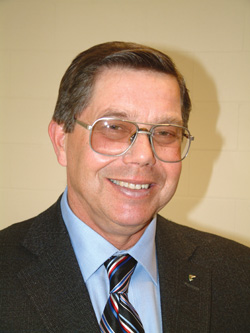
Crop circles in Niagara? They
won’t be a hoax to fool the public or attributed to alien landings.
There’s a simple explanation: Money, or rather the lack of it.
CFIA changes rules for PPV grower compensation
Crop circles in Niagara? They won’t be a hoax to fool the public or attributed to alien landings. There’s a simple explanation: Money, or rather the lack of it.
In just two years, tree fruit growers have used up $18 million of the $20 million set aside by the federal government to eradicate plum pox virus (PPV). With money running out, the Canadian Food Inspection Agency (CFIA) that administers the program arbitrarily changed the rules in mid-March.
 |
| Len Troup |
That’s upset a number of growers who decided against pulling out orchards last fall in order to test the CFIA’s science, as well as growers who might have otherwise been entitled to compensation in the future.
Growers will still be paid to pull out trees and replant, but will no longer be paid for lost income for removing an entire orchard if just one infected tree is found. They will now only be paid for removing only trees in a 15-metre radius of an infected tree.
The resulting 30-metre (just under 100 feet) “crop circles” will cut up orchards so badly they will no longer be viable, growers complained at the annual meeting of the Ontario Tender Fruit Producers’ Marketing Board (OTFPMB). Growers only learned about the change in compensation six days earlier at a regular task force meeting between the CFIA and a committee from the OTFPMB.
The committee recommended the board pursue a “management option” plan that would continue the removal of only infected trees and not neighbouring trees. That motion was narrowly defeated and amended to remove “management,” which growers felt should not be considered an option if PPV is to be eradicated. Some producers feared a management approach could result in the CFIA eventually walking away from the problem, leaving Niagara as the only PPV contaminated zone in North America.
The board hoped to hear back from the CFIA about any “option” by bud break in mid to late April. Their answer came when trees surrounding infected trees were marked for removal. The trees will have to be removed before the first generation of aphids fly in mid-June.
Grower Phil Andrewes, who made the amendment, advised other growers to stay the course and work toward eradication (which is now within sight) in hopes the new federal Conservative government could make more compensation money available.
“A lot of tax money is committed to the program and it is not in their (government’s) best interest if the auditor general made light of it,” Andrewes, a former Ontario Progressive Conservative cabinet minister said. He said the federal government “hasn’t the balls” to stop funding a program that is now on the threshold of eliminating PPV in Canada.
Massive mandatory pullouts were predicted over the next two years to eradicate PPV, a virus that isn’t a public health risk but is of particular concern to fresh market growers because of the blemishes it causes on peaches, nectarines and plums. Left unchecked, it reduces the sugar content of the fruit and causes it to fall from the tree prematurely, a concern to growers supplying both the fresh market and processors.
“It’s revolved on us,” said OTFPMB chair Len Troup. He’s been the board chairman since PPV was detected in 2000 and has, over the years, urged growers to stay the course set by the CFIA for the good of the industry.
The disease is believed to have come from Pennsylvania 10 years earlier and spread through budwood grown in Ontario that was being used to speed up plantings of peach varieties for the growing processing industry.
“Growers have to be disappointed by changes that took us by surprise,” Troup said, adding that it’s unfair to treat growers unequally in regards to compensation.
Twelve growers who questioned the CFIA’s science on what part aphids play in spreading PPV have particular reason to be upset. They could have removed orchard blocks (800 trees) last fall and been compensated for lost income. Instead, they removed only infected trees and asked the CFIA to test the wood of each tree to see if PPV had jumped to neighbouring trees.
Of the 31,232 trees tested in 57 orchards, 185 new positives were found. Thirty-nine orchards had one or more trees that tested positive; 15 were found to be clean, and three were still suspect.
“Those with the 15 clean blocks had to be happy,” Troup said. But they could be the same growers who also had one or more trees that tested positive in other blocks.
Two years ago, the federal government committed $85 million over seven years with the belief the money was more than enough to pay both compensation to growers and for extensive leaf testing each year. Up until Phase 2 funding was announced, the CFIA had been leaf testing to get a handle on the disease. In order to be declared eradicated, there has to be three years of leaf testing without finding any infected trees.
Print this page